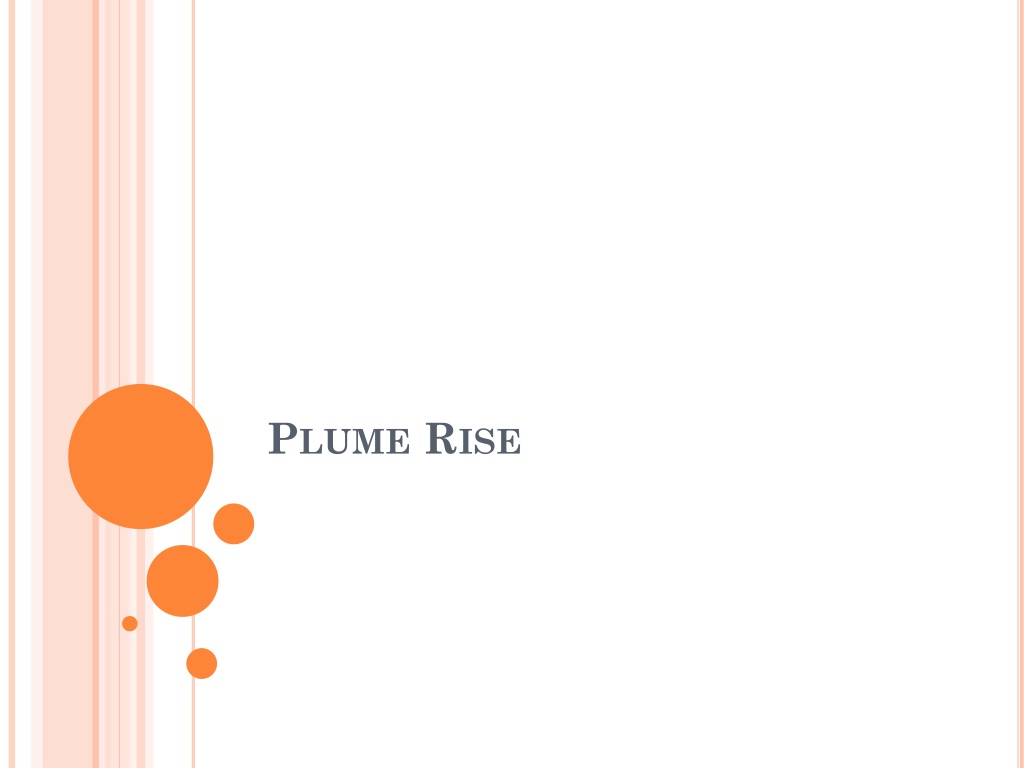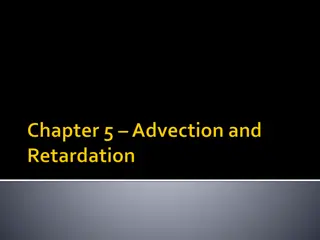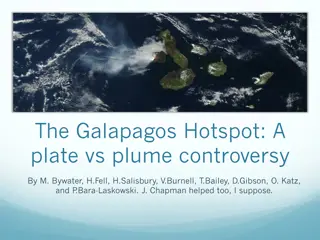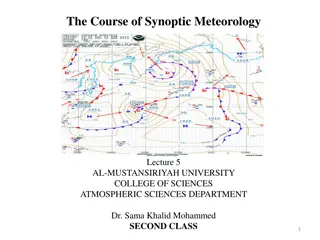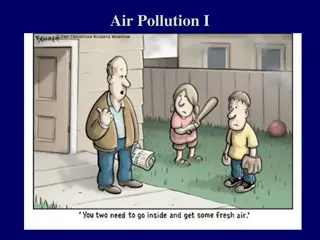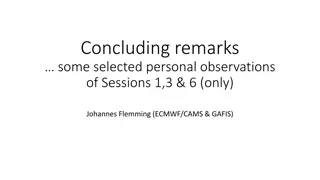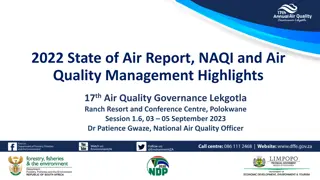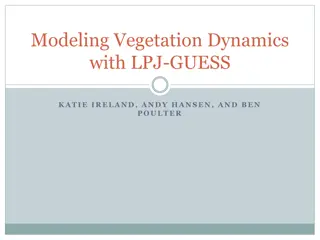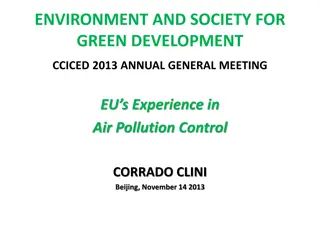Understanding Air Quality Modeling and Plume Dynamics
Exploring the purpose and types of air quality models, as well as the mechanisms of atmospheric transport and the basic segments of an elevated plume. Delve into the dispersion of heavy gases and the phases involved. Gain insights into policy analysis, regional planning, and emergency preparedness concerning air quality.
Uploaded on Sep 29, 2024 | 0 Views
Download Presentation

Please find below an Image/Link to download the presentation.
The content on the website is provided AS IS for your information and personal use only. It may not be sold, licensed, or shared on other websites without obtaining consent from the author. Download presentation by click this link. If you encounter any issues during the download, it is possible that the publisher has removed the file from their server.
E N D
Presentation Transcript
PURPOSE OF AIR QUALITY MODELING Policy Analysis Regional Planning Supplementary Control Systems / Air Quality Prediction System Emergency Preparedness / Accidental Releases Long Range Transport (Acid Rain) State Implementation Plan Revisions / New Source Review Prevention of Significant Deterioration ( PSD )
ATMOSPHERIC TRANSPORT Basic Mechanisms in the Movement of a Plume Advection Dispersion Treatment of Concentration Field Theoretical Approach Statistical theory Similarity theory K-Theory Models Higher Order Closure Models Experimental Approach Wind tunnel/ Water tank Field Studies (Expensive, Time Consuming & Limitation of Instrumentation )
TYPES OF AIR QUALITY MODELS Types of air quality models Emission rate Modeling Ambient Air Concentration Modeling Types of ground level concentration models Physical Model / Mathematical Model Historical Model Trend Model Prototype Model
BASIC SEGMENTS OF AN ELEVATED PLUME Initial phase Vertical Jet : Effluents are not deflected immediately upon entering the cross flow if (Vs / U > 4 ) Bent-Over Jet Section : Entrainment of the cross flow is rapid because by this time appreciable growth of vortices has taken place. Thermal Section : Self generated turbulence causes mixing and determines the growth of plume. Transition phase Plume's internal turbulence levels have dropped enough so that the atmospheric eddies in the inertial sub range determines the plume's growth. Diffusion phase The plume's own turbulence has dropped and energy containing eddies of atmospheric turbulence determine the growth of plume
DISPERSION OF HEAVY GASES Initial Acceleration Phase Initial Dilution Phase Slumping Phase (internal buoyancy-dominated dispersion ) Transition Phase Passive Phase ( atmospheric turbulence-dominated dispersion )
Types of Plume Continuous Plume: The release and the sampling time are long compared with the travel time. Puff Diffusion / Instantaneous Plume: The release time or sampling time is short when compared with the travel time Types of Plume Rise Buoyancy Effect: Rise due to the temperature difference between stack plume and ambient air. Momentum Rise: Rise due to exit velocity of the effluents (emissions).
CONCEPT OF PLUME PENETRATION Meteorology plays an important role in the dispersion of effluents. Various meteorological factors affect the dispersion of emission into the atmosphere in a variety of ways. Convective boundary layer (or mixing height) is one of the most important meteorological variables responsible for high ground level concentrations.
PLUME RISE MODELS Semi empirical equations based on heat flux Analytical solutions Numerical models
TERMS USED IN PLUME RISE CALCULATIONS Buoyancy Flux (F): g = Acceleration due to gravity Vs = Stack exit velocity d = Exit gas diameter Ts = Stack gas exit temperature Ta = Ambient air temperature Momentum Flux (Fm):
STABILITY PARAMETER . g z = S T a Where, z= AmbientPot entialTemp erature
ANALYTICAL SOLUTIONS Momentum Sources For Unstable and Neutral conditions For Stable conditions The lower value of the above equations is used for the concentration calculations.
ANALYTICAL SOLUTIONS Buoyant plumes For Unstable and Neutral conditions x* = 14 F 5/8 when F < = 55 m4/sec3 x* = 34 F 2/5 when F > 55 m4/sec3 3.5x* = Downwind distance to the point of final rise For Stable conditions The distance to final rise is given by
Determination of the Type of Plume (Momentum or Buoyant) Crossover Temperature (DTc) Unstable or Neutral case 3 / 2 d s V 0297 . 0 = * 55 / sec T T for F m s 4 3 c s 3 / 1 V 3 / 1 s 00575 . 0 = = * 55 / sec T T for F m 4 3 c s 3 / 2 d s Buoyancy rise if DT >= DTc or is assumed to be Momentum Stable case s T TC * 019582 . 0 = V S s The above calculations are valid for cases with stack exit temperature Ts greater than or equal to ambient temperature Ta.
Plumes Under Calm Conditions and Jets For Calm Conditions For wind speeds < 1 m/sec The plume rise for a jet is computed as follows: h = 4.0 Fm1/4 S -1/4
Calculate the buoyancy flux of a source for the following conditions: Vs ds Ts Ta 19 m/s 3m 400 K 283 K
SOLUTION Step 1: T = Ts Ta Step 2: Buoyancy Flux F = (g * Vs * ds * T )/ (4 * Ts) F = 122.67 m4/s3
Determine the plume rise from a 40 m high stack if the buoyancy flux from the source is 50 m4/sec3 and the wind velocity is 5 m/sec. The atmospheric condition is slightly unstable.
SOLUTION Step 1: Determine if the plume is buoyant or momentum. Step 2: x* = 14 F 5/8 when F < = 55 m4/sec3 x* = 161.43 Step 3:
SEMI-EMPIRICAL EQUATIONS Most of the plume rise equations in this category are based on the following equations where, Qh is the heat emission rate of the source Qh = Qm Cp (Ts - Ta) where, Qm is the total mass emission rate Qm = ( /4) s d2 Vs
NUMERICAL MODELS Conservation of Mass Conservation of Moisture Conservation of Energy (Heat) Conservation of Momentum
NUMERICAL MODELS Conservation of Horizontal Momentum Conservation of Solid Particles
Relationship between Plume Rise z, Downwind Distance x and Time t Hydrostatic Environment - No Liquid or Solid Particulate Matter Assumptions made in developing the above equations Boussinesq approximation has not been used Solid body effects are included only in the horizontal direction Downwash is neglected during computations i.e. We = 0
PROBLEM Stack Diameter - 2.24 m - 61.00 m - 20.00 m/sec 1000.00 K Stack Height Stack Exit Velocity Stack Exit Temperature - Atmospheric Temperature - 281.00 K Emission Rate - 348.26 g/sec Wind Speed at stack height - 5.70 m/sec Calculate the plume rise for stable, unstable, and neutral atmospheric conditions.
PROCEDURE Calculate F Calculate Tc Decide buoyancy/momentum/calm Choose the plume rise equation Calculate h
PROBLEM The wind and stack gas speeds are 3 m/sec at 10 m and 6 m/sec, respectively. The stack diameter is 2 m. The atmospheric condition is near neutral with an average temperature of 300 K. The stack gas temperature is 450 K. Estimate plume rise. The stack height is 50 m.
FLARE STACK Flare Length as per API where, L = 0.006 Q0.478 L = Flare length (ft) Q = Flared gas heat release (BTU/hr) Vertical Height of Flame hfv = L Sin = 45 Plume Rise He = hs + hfv + h
INTRODUCTIONOFPLUMERISE Plume rise - the height to which a plume emitted from an elevated source will rise. Importance: to the estimation of ambient pollutant concentration, impact on the local and distant environment. Affected by: the initial sources conditions (exit velocity and temperature difference between the plume and the air), the stable class and stratification of the atmosphere, and the wind field.
GENERALCALCULATIONOFPLUMERISE Basic formulas of plume rise h = b Ex a u
CALCULATIONOFFIRE-PLUMERISE Features of wild land fire plume - can not be treated in the same sense as those stack point sources, but usually be considered as an area source. - with a low initial momentum, the wildfire plume rise is dominated by the buoyancy. - continue near-surface release.
CALCULATIONOFFIRE-PLUMERISE h : the plume rise of fire plume, m x: the downward distance, r0: fire radius, m K: the velocity ratio, ( ) U 10-m wind speed, m/s : the entrainment coefficient ( =0.6) F : the Froude number, Basic equation U w 0 1 3 2 3 3 r x r r = + 0 F 0 0 h 1 4 2 2 3 K 2 0 w 2 = a F 2 g w0 : the initial vertical velocity, m/s a: ambient density, kg/m3 : the initial density difference between ambient air and the fire plume. ( a- p) 6 8 . 8 g 10 Q T = h r P w ( ) 0 2 T T P a P TP, Ta : temperature of plume and ambient respectively, K rP: the radius of fire, m Qh: the heat release rate, J/s
DIFFERENTCASESOFCALCULATIONOF FIRE-PLUMERISE Stable conditions Plume rise is limited by thermal stratification 1 2 r U 3 = 0 F 1 . 2 hf 2 2 3 N K hf is the final rise, m N is the Brunt Vasaila frequency 1 g 2 = N z
DIFFERENTCASESOFCALCULATIONOF FIRE-PLUMERISE (CON T) Neutral conditions Ambient turbulence limits the final plume rise by breaking up the plume 2 r U (Briggs, 1984) = 0 F . 0 76 hf 2 2 3 u K * u*: friction velocity, m/s
DIFFERENTCASESOFCALCULATIONOF FIRE-PLUMERISE (CON T) Unstable conditions Plume rise is also limited by turbulence 3 2 5 2 r U z 3 (Briggs, 1989; Weil, 1988) = 0 i 5 . 4 h f 2 2 3 4 w F K * 1 zi : inversion height, m w*: the convection velocity scale, m/s ( ) g 3 = ' ' w w z * i v
